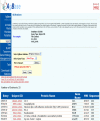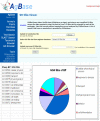AgBase: a functional genomics resource for agriculture
- PMID: 16961921
- PMCID: PMC1618847
- DOI: 10.1186/1471-2164-7-229
AgBase: a functional genomics resource for agriculture
Abstract
Background: Many agricultural species and their pathogens have sequenced genomes and more are in progress. Agricultural species provide food, fiber, xenotransplant tissues, biopharmaceuticals and biomedical models. Moreover, many agricultural microorganisms are human zoonoses. However, systems biology from functional genomics data is hindered in agricultural species because agricultural genome sequences have relatively poor structural and functional annotation and agricultural research communities are smaller with limited funding compared to many model organism communities.
Description: To facilitate systems biology in these traditionally agricultural species we have established "AgBase", a curated, web-accessible, public resource http://www.agbase.msstate.edu for structural and functional annotation of agricultural genomes. The AgBase database includes a suite of computational tools to use GO annotations. We use standardized nomenclature following the Human Genome Organization Gene Nomenclature guidelines and are currently functionally annotating chicken, cow and sheep gene products using the Gene Ontology (GO). The computational tools we have developed accept and batch process data derived from different public databases (with different accession codes), return all existing GO annotations, provide a list of products without GO annotation, identify potential orthologs, model functional genomics data using GO and assist proteomics analysis of ESTs and EST assemblies. Our journal database helps prevent redundant manual GO curation. We encourage and publicly acknowledge GO annotations from researchers and provide a service for researchers interested in GO and analysis of functional genomics data.
Conclusion: The AgBase database is the first database dedicated to functional genomics and systems biology analysis for agriculturally important species and their pathogens. We use experimental data to improve structural annotation of genomes and to functionally characterize gene products. AgBase is also directly relevant for researchers in fields as diverse as agricultural production, cancer biology, biopharmaceuticals, human health and evolutionary biology. Moreover, the experimental methods and bioinformatics tools we provide are widely applicable to many other species including model organisms.
Figures






Similar articles
-
AgBase: a unified resource for functional analysis in agriculture.Nucleic Acids Res. 2007 Jan;35(Database issue):D599-603. doi: 10.1093/nar/gkl936. Epub 2006 Nov 29. Nucleic Acids Res. 2007. PMID: 17135208 Free PMC article.
-
AgBase: supporting functional modeling in agricultural organisms.Nucleic Acids Res. 2011 Jan;39(Database issue):D497-506. doi: 10.1093/nar/gkq1115. Epub 2010 Nov 12. Nucleic Acids Res. 2011. PMID: 21075795 Free PMC article.
-
Developing a biocuration workflow for AgBase, a non-model organism database.Database (Oxford). 2012 Nov 17;2012:bas038. doi: 10.1093/database/bas038. Print 2012. Database (Oxford). 2012. PMID: 23160411 Free PMC article.
-
An Experimental Approach to Genome Annotation: This report is based on a colloquium sponsored by the American Academy of Microbiology held July 19-20, 2004, in Washington, DC.Washington (DC): American Society for Microbiology; 2004. Washington (DC): American Society for Microbiology; 2004. PMID: 33001599 Free Books & Documents. Review.
-
Gene Ontology annotation of the rice blast fungus, Magnaporthe oryzae.BMC Microbiol. 2009 Feb 19;9 Suppl 1(Suppl 1):S8. doi: 10.1186/1471-2180-9-S1-S8. BMC Microbiol. 2009. PMID: 19278556 Free PMC article. Review.
Cited by
-
Characterization of the endothelial cell cytoskeleton following HLA class I ligation.PLoS One. 2012;7(1):e29472. doi: 10.1371/journal.pone.0029472. Epub 2012 Jan 11. PLoS One. 2012. PMID: 22247778 Free PMC article.
-
Identification of QTNs and Their Candidate Genes for Boll Number and Boll Weight in Upland Cotton.Genes (Basel). 2024 Aug 5;15(8):1032. doi: 10.3390/genes15081032. Genes (Basel). 2024. PMID: 39202392 Free PMC article.
-
Phylogenomic diversity of Vibrio species and other Gammaproteobacteria isolated from Pacific oysters (Crassostrea gigas) during a summer mortality outbreak.Microb Genom. 2022 Dec;8(12):mgen000883. doi: 10.1099/mgen.0.000883. Microb Genom. 2022. PMID: 36748707 Free PMC article.
-
GOModeler--a tool for hypothesis-testing of functional genomics datasets.BMC Bioinformatics. 2010 Oct 7;11 Suppl 6(Suppl 6):S29. doi: 10.1186/1471-2105-11-S6-S29. BMC Bioinformatics. 2010. PMID: 20946613 Free PMC article.
-
Genetic mapping and genomic selection for maize stalk strength.BMC Plant Biol. 2020 May 7;20(1):196. doi: 10.1186/s12870-020-2270-4. BMC Plant Biol. 2020. PMID: 32380944 Free PMC article.
References
-
- Hillier LW, Miller W, Birney E, Warren W, Hardison RC, Ponting CP, Bork P, Burt DW, Groenen MA, Delany ME, Dodgson JB, Chinwalla AT, Cliften PF, Clifton SW, Delehaunty KD, Fronick C, Fulton RS, Graves TA, Kremitzki C, Layman D, Magrini V, McPherson JD, Miner TL, Minx P, Nash WE, Nhan MN, Nelson JO, Oddy LG, Pohl CS, Randall-Maher J, Smith SM, Wallis JW, Yang SP, Romanov MN, Rondelli CM, Paton B, Smith J, Morrice D, Daniels L, Tempest HG, Robertson L, Masabanda JS, Griffin DK, Vignal A, Fillon V, Jacobbson L, Kerje S, Andersson L, Crooijmans RP, Aerts J, van der Poel JJ, Ellegren H, Caldwell RB, Hubbard SJ, Grafham DV, Kierzek AM, McLaren SR, Overton IM, Arakawa H, Beattie KJ, Bezzubov Y, Boardman PE, Bonfield JK, Croning MD, Davies RM, Francis MD, Humphray SJ, Scott CE, Taylor RG, Tickle C, Brown WR, Rogers J, Buerstedde JM, Wilson SA, Stubbs L, Ovcharenko I, Gordon L, Lucas S, Miller MM, Inoko H, Shiina T, Kaufman J, Salomonsen J, Skjoedt K, Wong GK, Wang J, Liu B, Yu J, Yang H, Nefedov M, Koriabine M, Dejong PJ, Goodstadt L, Webber C, Dickens NJ, Letunic I, Suyama M, Torrents D, von Mering C, Zdobnov EM, Makova K, Nekrutenko A, Elnitski L, Eswara P, King DC, Yang S, Tyekucheva S, Radakrishnan A, Harris RS, Chiaromonte F, Taylor J, He J, Rijnkels M, Griffiths-Jones S, Ureta-Vidal A, Hoffman MM, Severin J, Searle SM, Law AS, Speed D, Waddington D, Cheng Z, Tuzun E, Eichler E, Bao Z, Flicek P, Shteynberg DD, Brent MR, Bye JM, Huckle EJ, Chatterji S, Dewey C, Pachter L, Kouranov A, Mourelatos Z, Hatzigeorgiou AG, Paterson AH, Ivarie R, Brandstrom M, Axelsson E, Backstrom N, Berlin S, Webster MT, Pourquie O, Reymond A, Ucla C, Antonarakis SE, Long M, Emerson JJ, Betran E, Dupanloup I, Kaessmann H, Hinrichs AS, Bejerano G, Furey TS, Harte RA, Raney B, Siepel A, Kent WJ, Haussler D, Eyras E, Castelo R, Abril JF, Castellano S, Camara F, Parra G, Guigo R, Bourque G, Tesler G, Pevzner PA, Smit A, Fulton LA, Mardis ER, Wilson RK. Sequence and comparative analysis of the chicken genome provide unique perspectives on vertebrate evolution. Nature. 2004;432:695–716. doi: 10.1038/nature03154. - DOI - PubMed
-
- Gill BS, Appels R, Botha-Oberholster AM, Buell CR, Bennetzen JL, Chalhoub B, Chumley F, Dvorak J, Iwanaga M, Keller B, Li W, McCombie WR, Ogihara Y, Quetier F, Sasaki T. A workshop report on wheat genome sequencing: International Genome Research on Wheat Consortium. Genetics. 2004;168:1087–1096. doi: 10.1534/genetics.104.034769. - DOI - PMC - PubMed
Publication types
MeSH terms
LinkOut - more resources
Full Text Sources
Other Literature Sources
Research Materials

